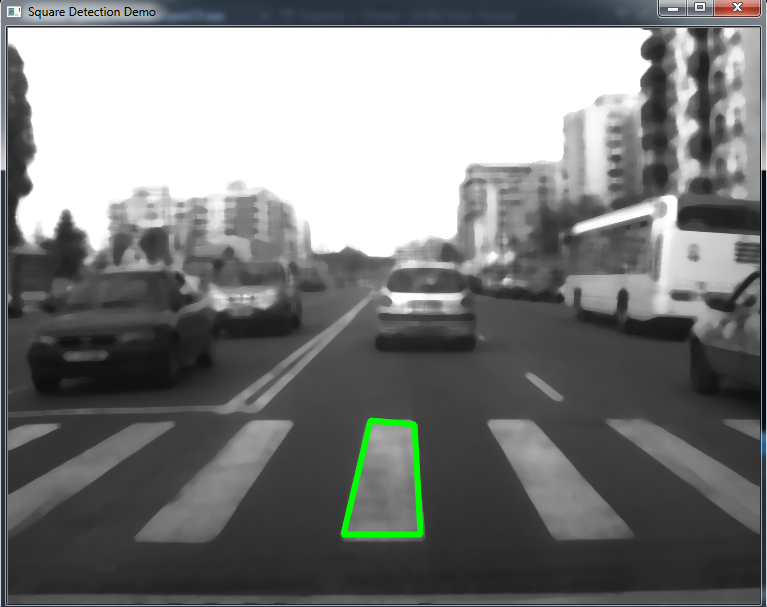Hello everyone. I have tried this tutorial, and unfortunately I didn't really get it. Can anyone tell/explain me how can I filter also the other rectangles from the ZebraCrossing, not only the middle one. (Result attached).
Many thanks !
Here is the code:
#include <stdio.h>
#include <iostream>
#include "opencv2/core/core.hpp"
#include "opencv2/features2d/features2d.hpp"
#include "opencv2/highgui/highgui.hpp"
#include "opencv2/calib3d/calib3d.hpp"
#include "opencv2/nonfree/nonfree.hpp"
using namespace cv;
/** @function main */
#include "opencv2/core/core.hpp"
#include "opencv2/imgproc/imgproc.hpp"
#include "opencv2/highgui/highgui.hpp"
#include <iostream>
#include <math.h>
#include <string.h>
using namespace cv;
using namespace std;
int thresh = 50, N = 5;
const char* wndname = "Square Detection Demo";
// helper function:
// finds a cosine of angle between vectors
// from pt0->pt1 and from pt0->pt2
static double angle(Point pt1, Point pt2, Point pt0)
{
double dx1 = pt1.x - pt0.x;
double dy1 = pt1.y - pt0.y;
double dx2 = pt2.x - pt0.x;
double dy2 = pt2.y - pt0.y;
return (dx1*dx2 + dy1*dy2) / sqrt((dx1*dx1 + dy1*dy1)*(dx2*dx2 + dy2*dy2) + 1e-10);
}
// returns sequence of squares detected on the image.
// the sequence is stored in the specified memory storage
static void findSquares(const Mat& image, vector<vector<Point> >& squares)
{
squares.clear();
//s Mat pyr, timg, gray0(image.size(), CV_8U), gray;
// down-scale and upscale the image to filter out the noise
//pyrDown(image, pyr, Size(image.cols/2, image.rows/2));
//pyrUp(pyr, timg, image.size());
// blur will enhance edge detection
Mat timg(image);
cv::medianBlur(image, timg, 9);
Mat gray0(timg.size(), CV_8U), gray;
vector<vector<Point> > contours;
// find squares in every color plane of the image
for (int c = 0; c < 3; c++)
{
int ch[] = { c, 0 };
mixChannels(&timg, 1, &gray0, 1, ch, 1);
// try several threshold levels
for (int l = 0; l < N; l++)
{
// hack: use Canny instead of zero threshold level.
// Canny helps to catch squares with gradient shading
if (l == 0)
{
// apply Canny. Take the upper threshold from slider
// and set the lower to 0 (which forces edges merging)
Canny(gray0, gray, 5, thresh, 5);
// dilate canny output to remove potential
// holes between edge segments
dilate(gray, gray, Mat(), Point(-1, -1));
}
else
{
// apply threshold if l!=0:
// tgray(x,y) = gray(x,y) < (l+1)*255/N ? 255 : 0
gray = gray0 >= (l + 1) * 255 / N;
}
// find contours and store them all as a list
findContours(gray, contours, RETR_LIST, CHAIN_APPROX_SIMPLE);
vector<Point> approx;
// test each contour
for (size_t i = 0; i < contours.size(); i++)
{
// approximate contour with accuracy proportional
// to the contour perimeter
approxPolyDP(Mat(contours[i]), approx, arcLength(Mat(contours[i]), true)*0.02, true);
// square contours should have 4 vertices after approximation
// relatively large area (to filter out noisy contours)
// and be convex.
// Note: absolute value of an area is used because
// area may be positive or negative - in accordance with the
// contour orientation
if (approx.size() == 4 &&
fabs(contourArea(Mat(approx))) > 1000 &&
isContourConvex(Mat(approx)))
{
double maxCosine = 0;
for (int j = 2; j < 5; j++)
{
// find the maximum cosine of the angle between joint edges
double cosine = fabs(angle(approx[j % 4], approx[j - 2], approx[j - 1]));
maxCosine = MAX(maxCosine, cosine);
}
// if cosines of all angles are small
// (all angles are ~90 degree) then write quandrange
// vertices to resultant sequence
if (maxCosine < 0.3)
squares.push_back(approx);
}
}
}
}
}
// the function draws all the squares in the image
static void drawSquares(Mat& image, const vector<vector<Point> >& squares)
{
for (size_t i = 0; i < squares.size(); i++)
{
const Point* p = &squares[i][0];
int n = (int)squares[i].size();
//dont detect the border
if (p->x > 3 && p->y > 3)
polylines(image, &p, &n, 1, true, Scalar(0, 255, 0), 3, CV_AA);
}
imshow(wndname, image);
}
int main(int /*argc*/, char** /*argv*/)
{
static const char* names[] = { "a001285-1.bmp", "a001281-1.bmp", 0 };
namedWindow(wndname, 1);
vector<vector<Point> > squares;
for (int i = 0; names[i] != 0; i++)
{
Mat image = imread(names[i], 1);
if (image.empty())
{
cout << "Couldn't load " << names[i] << endl;
continue;
}
findSquares(image, squares);
drawSquares(image, squares);
//imwrite( "out", image );
int c = waitKey();
if ((char)c == 27)
break;
}
return 0;
}


